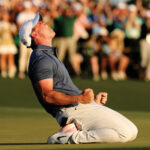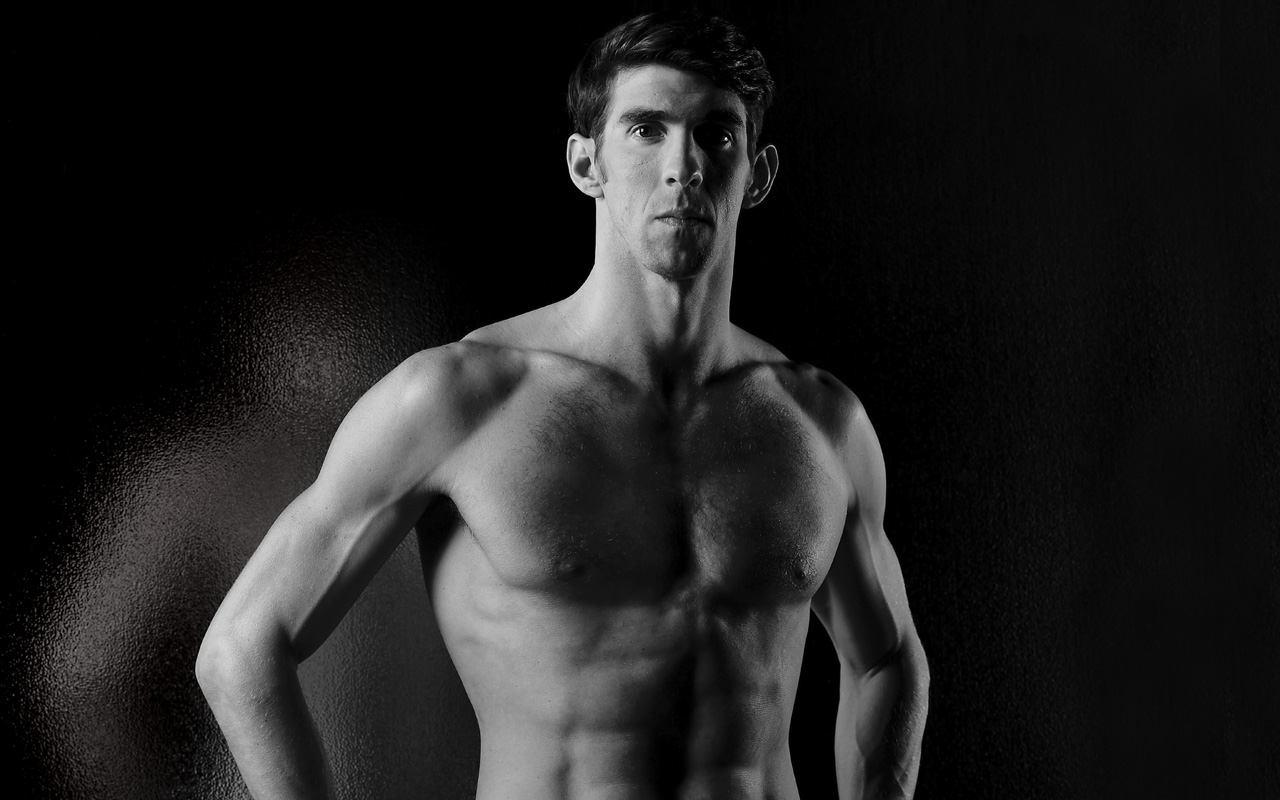
Michael Phelps is the most successful and most decorated Olympian of all time with a total of 28 medals. Phelps also holds the all-time records for Olympic gold medals, Olympic gold medals in individual events, and Olympic medals in individual events.
Researchers agree that child prodigies display two key components: 1) A rage to mastery. 2) An ability to learn quickly. When those two elements are combined with a third dimension: a voracious work ethic, unimaginably great heights can be achieved.
Michael Phelps
Michael Phelps, the greatest Olympian of all time, strongly displays those three vital elements: a rage to mastery; an ability to learn quickly, and an indescribably committed work ethic. In his chosen sport of swimming, 6-foot-4-inch Phelps also has a fourth gift: the perfect swimmer’s body with a very long torso that propels him through the water like the hull of a boat; comparatively shorter legs that produce less drag (water resistance); flipper-like feet, and most importantly, a huge wingspan that branches off from a large chest. A wider wingspan means his arms can reach farther, and when winning a race is oftentimes a fraction of a second, even a small advantage in wingspan can make a big difference. Swimming is a particularly lonely sport, and it took Phelps’ intense passion and determination to achieve his goals so seismically. He and coach Bob Bowman worked on precision excellence in every facet of the sport. Phelps’ acute intelligence also played a large part in his success. He displayed exceptional awareness in Olympic races and was a savant when it came to stats and kinesthesiology.
‘Search for Greatness’ (Peacock App) is an in-depth movie on what makes an athlete truly great. Those who have reached greatness in their respective sports explain where they started and how they achieved long-term success. Interestingly, Wayne Gretzky and Jerry Rice, disagree with some of the theories, and experts weigh in on the multi-dimensional factors – both genetic and environmental – that lead to greatness. It’s a fascinating study.
Wayne Gretzky
Immediately negating the theory on physical prototypes for a particular sport, Wayne Gretzky says: “If they had me in the hockey Combine, I’d probably be rated at the lowest end because I couldn’t bench 195 pounds. Jumping is not something I’m great at. My cardio is my forte, so I would do well at the anaerobic part of it. But that doesn’t make you a great hockey player. That’s only part of it. Sometimes, way too much is read into this stuff. I didn’t have the hardest shot in the game, but I guarantee you that I had one of the most accurate shots. If I saw a spot, I made sure to put it there. The game is about having the puck! The game is about scoring goals. It’s not about pushups and how high a guy can jump off the ice. One of my key strengths was survival. I didn’t have the strength and size to protect myself physically against the other guys. At age 14, I was 5’6” tall and weighed 120 lbs., and I was playing with some huge 19 and 20-year-old men. On my very first practice, my coach advised me to go home and study a player who played the game out of the corners. I started to play from the corners and behind the net. Nobody had ever done that before, and I started to use the net as a decoy. Consequently, I wasn’t standing in front of it and being knocked over all the time. I never relied on speed or power. What I knew was going to get me to the next level was my wisdom and my vision on the ice. When I was 4 years old and watching hockey in Canada, I’d take a piece of paper and draw a rink. Without looking at the paper, I’d watch the hockey game on TV and I’d follow the puck with my pen on the paper. I became adept at seeing which part of the ice the puck was in more often, and I’d do that every game. Being a kid is about playing with your friends, and in the process, you get highly creative.”
Gretzky’s father also had a profound impact. Wayne remembers being in the car with him when he was 10 years old and his dad said, “There are players in the NHL who are too structured. The defense stays back; the left or right wingers stay in their space.” Gretzky said that his father was absolutely correct. “If I look at kids today, they are all so structured and everything is so analytical, so if you said to them, ‘let’s go to an iced-up pond and play hockey’, they’d likely ask you what they should do. Creativity and imagination are not enhanced when there’s too much structure. The problem is that there is so much competitiveness and money in sports today that parents of 8, 9 and 10-year-old kids are putting them in home schools; they go to hockey or football academies. They specialize very early. What I have learned is that every sport you participate in helps you to perfect your eventual chosen sport. When I was a kid and hockey season was over, I couldn’t wait to put my baseball glove on and go out and play. Lacrosse is all about eye hand coordination. Baseball is about all the mental thinking that feeds the creativity and imagination. Those components became vital to my hockey career. Parents often come up to me and say, “Can you tell my kid how many hours a day he must practice.” My response is always, “I never practiced. Hockey was a passion, and I did it all day long because I loved it. I was never told to go out and practice. I went out into the backyard and shot pucks for hours because it made me happy.”
Gretzky also subscribes to the non-conformity theory. He says, “I left a particular coach because his rigid style of play wasn’t copacetic to the style of play that I was used to. My awareness was my creativity. I knew instinctively what to sidestep or what to move towards. The game is so fast and played at such an intense physical level that you truly don’t have time to think on the ice. You allow your instincts to direct you. In hockey, I can remember every single play of every single game of every single night because of my passion. It was easy.”
Creativity
According to David Epstein, author of ‘The Sports Gene’, the key is not to become a slave to data analytics. Some things that aren’t measurable are sometimes much more important. He says, “I think the Combine measurements can be stupid. One of the major reasons is that they don’t test for creativity. What we know is that networks of genes work together in concert with the environment. While there’s no such thing as a sports gene, there are some innate biological factors that predispose some people to being successful in some sports, but I don’t think that’s where we should look for the competitive advantage anymore.”
Epstein talks about the importance of teaching a young child skills like language and sport where they aren’t articulating what they are learning. It just becomes natural through a process of self-discovery. You work on yourself by making changes. It’s a completely autonomous learning curve in which you are in charge. We see this in chess. If kids study too rigidly, they become stuck in their play and hit a plateau with no improvement. Unstructured time allows them space to figure out and surmount the plateau. But many parents believe that their kid has to specialize as early as possible and that limits their horizons. The development of an elite athlete means that they should sample a variety of sports early on – and only later in life – should they specialize. Kids who question a coach’s goals are also the ones who usually end up exceling in the sport. When they do repetitive drills, they are more likely to say to the coach, ‘Why are we doing this?’
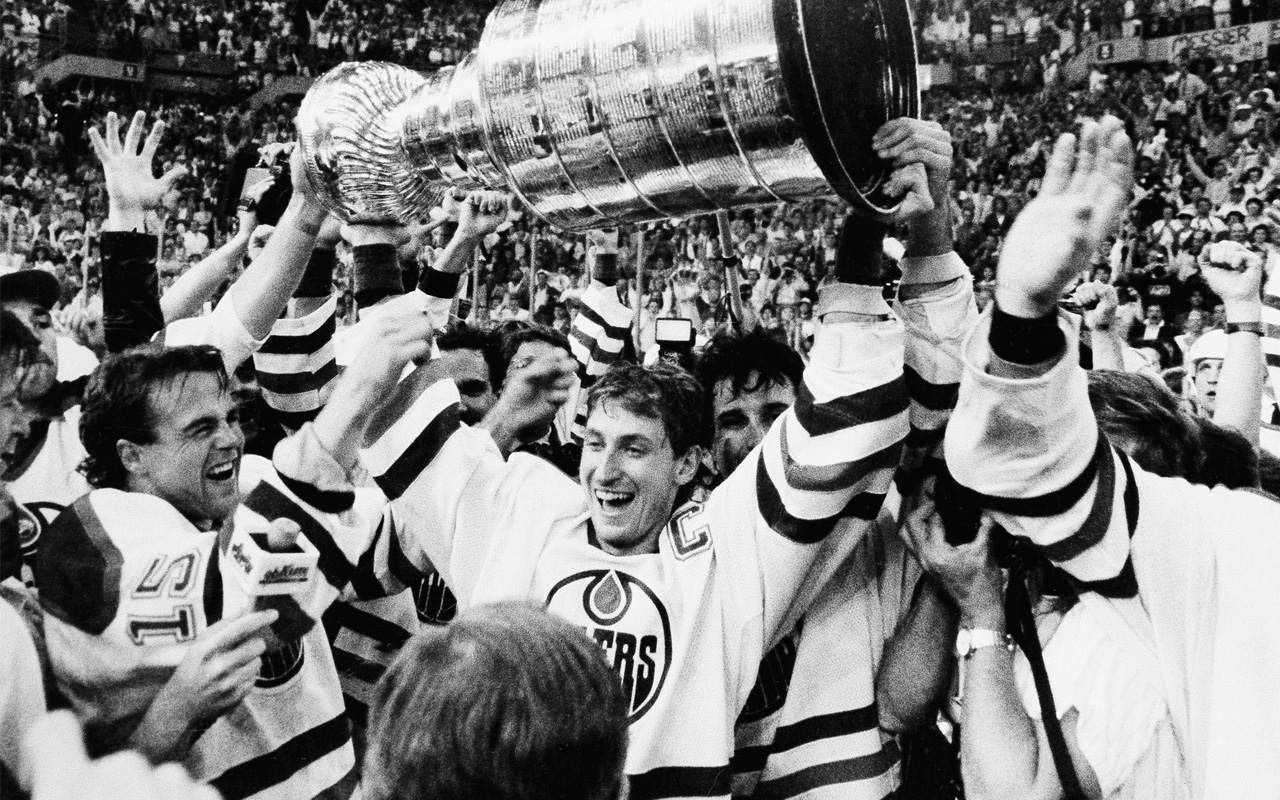
Nicknamed “The Great One”, Wayne Gretzky is the leading goal scorer, assist producer and point scorer in NHL history, and has more career assists than any other player has total points.
Intuition
Elite athletes quickly master the fundamentals, so excessive repetition bores them. They also have enhanced intuition. They instinctively move their body parts to places that the average person wouldn’t know to do. A classical pianist intuitively knows where their fingers are going to move in the next minute. They see what’s going to happen before it actually happens. It’s an intrinsic instinct. Epstein talks about how a gifted athlete performs in a team game: he/she has an instant ability to group players in a team game and draw information at terrific speed from it.
Sir Ken Robinson, author of ‘Out of Our Minds: Learning to be Creative’ agrees with Epstein. He says, “I’m not against stats diagnostically. They can be useful. But it’s oftentimes the unconventional player that stands out in sport because he/she becomes highly creative and adept at outfoxing the opposition. This was particularly evident in heavyweight boxer, Rocky Marciano, who didn’t fit the textbook stats at all. His undefeated career was a testament to his strategy.”
Freedom to Experiment
Robinson continues: “The earlier you expose a young child to things like language and sports, the easier they pick them up. Look at Tiger Woods as an example. He was hitting a golf ball the second he could stand. It became innate and implicit. A big part of success is giving people the freedom to experiment and to learn from mistakes. That trial-and-error format in childhood is a vital bedrock for skill enhancement. There’s too much structured time in schools now. Kids in urban settings in the USA have less unstructured time than prison inmates. That’s not good. Kids who are over-scheduled – suffer. Childhood is a precious time, and it lays the foundation for the rest of your life.”
Non-Conformity, Ideas, and Imagination
“When it comes to coaching sports,” says Robinson, “there’s this pressure to conform. Follow the formula; be compliant. That’s essentially the death knell recipe because people are diverse, creative and they want fulfilment. Drudgery and dreary repetitiveness are what turn people away. The people who achieve real greatness don’t fit the formula at all. They break the mold. Kids who question the rule book aren’t necessarily showing disrespect. They just think that there may be a better way of doing it. Look at John McEnroe who stood up to the umpires at Wimbledon and told them that their calls were flat wrong. He was correct and as a result of his emotional outbursts on center court, the Wimbledon authorities were forced to enhance and upgrade their systems to combat human errors – that had a calamitous effect on players’ tennis careers.”
Humans are a species that thrive on ideas and imagination. If you look at Tom Brady, the most successful Quarterback in NFL history, the stats at the inception would have given him a terrible report for his potential football playing career. He was ‘skinny’, supposedly ‘poorly built,’ lacked a strong arm, lacked ‘physical stature’. Boy, were all those data markers wrong on this one! There’s a much-played televised altercation of Tom Brady and Bill O’ Brien having a heated argument on the football field. Clearly O’Brien wanted Brady to do things his way, and Brady, the gifted athlete, was frustrated with a completely different viewpoint to O’Brien.
Pelé
According to soccer great, Pele, the most impressive athlete he ever saw was a player named Garrincha. He rose to the top of soccer even though he was born with a leg disability. He had non-symmetrical knees that bowed in and out in the wrong places. In theory, he shouldn’t even have been able to walk. Yet his disability became an asset and influenced his unique style of play. More importantly, he was on fire during every game.
An important aspect about Pelé is that he never had any formal training in soccer as a child. He was street taught. According to Epstein, the German soccer team that recently performed exceptionally well had one thing in common: Most of the men in the team grew up playing street soccer where there was zero structure.
Jerry Rice
Just like Wayne Gretzky negated the emphasis on Combine stats, football great, Jerry Rice, agrees. “I don’t think I was the most talented receiver to play in the NFL. I’m referring to my size and speed. You look at the NFL Combine, they base so much off the 40. If you can run a good 40-yard dash time, that can throw you right up into the first round, but that doesn’t mean that you are going to be a great football player. I never had a good 40-yard time, but I knew that I had good football speed.”
On the topic of genetics, Jerry laughed. “I didn’t have better genetics. What I did was work on certain qualities. Maybe, because of my speed, I had to run disciplined routes. Timing is everything in football, so I had this clock inside my head, and the ball was halfway to me before I came out of my route.”
In complete agreement with Epstein’s and Robinson’s assertions that childhood is a critical time to learn skills that become naturally innate, Rice describes himself in childhood.
“What I’d do as a young boy is have the football in my hands all the time – to get the feel for it. At night when I was in bed and the room was dark, I’d toss the ball up in the air, and I developed an ability to catch the football in the pitch black. It was about knowing exactly where I’d positioned the ball and instinctually knowing where to catch it.”
“I didn’t start playing football until my sophomore year in high school,” Rice explains. “I’d watch Bruce Lee movies and I was enamored with his physical toughness. I subconsciously took so many of those Bruce Lee moves with me when I became serious about football. I learned to fight for my ground on the field by remembering some of those wonderful Bruce Lee moves!” It speaks to the importance of having a childhood in which lots of activities and interests stimulate and light up a young person’s imagination.
Rice continues: “The rotation of the ball became something that was so large in my imagination. It’s as if the game slowed down. I remember every minute detail of how the ball used to rotate as it came towards me. I was told that I was always running in my sleep. You play the game in your sleep. It permeates your subconscious at all times. The incredible thing is that my dreams often played out in games. It became part of my visualization.”
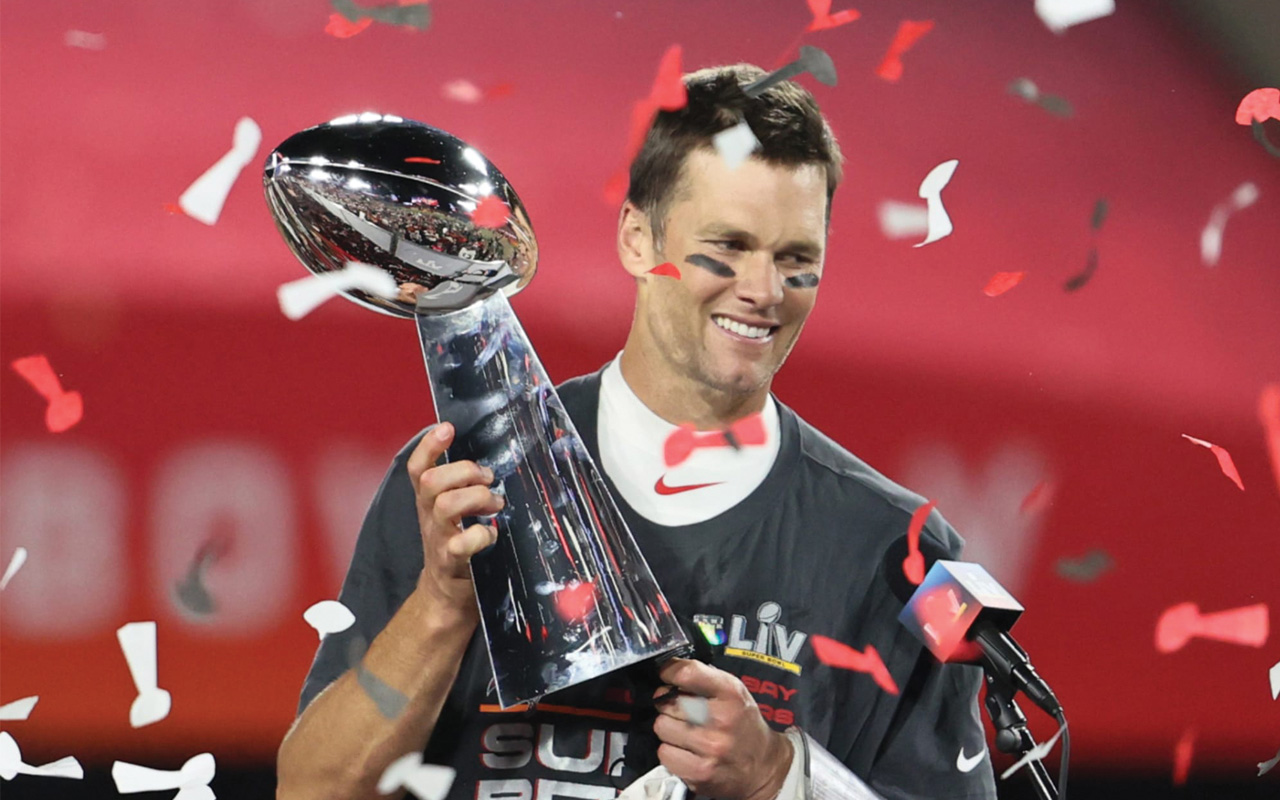
Tom Brady (The GOAT) is the winningest quarterback in NFL history, Brady won 251 regular season games and 35 postseason games for a combined 286 wins. He is the only NFL quarterback to win 200 regular season games and his 35 postseason victories are more than twice those of any other quarterback, and owns seven Super Bowl titles
Venus and Serena Williams
Venus and Serena Williams’ father had a vital part to play in their unconventional childhood. They grew up poor in Los Angeles, and Richard Williams would have Venus and Serena throwing tennis racquets as far as they could on grass to develop their throwing skills. That eventually built up solidly strong muscles for their tennis game wherein they both had lethally strong serves. Serena Williams went on to have the more successful career because she had determination second to none. Her mental strength was inestimable.
What all elite athletes agree upon is that possessing that driving passion for the sport is imperative. They all possess that rage for mastery, and the ways to achieve that include creativity, intuition, visualization, and speed. They master the skills much more quickly than an average athlete. A strong work ethic is also vital – although many athletes don’t view it as work because they love what they do. Elite athletes all endure physical pain, massive disappointments that make world news, and hardships, but they have immense mental fortitude.
While Michael Phelps’ physical attributes have been a strong component behind his successes, other greats in other sports don’t view a genetic protype as essential in their field. Passion, drive, and an ability to survey the landscape quickly and expertly – appear to be critical advantages. Intuition is inestimably valuable. Outfoxing the opposition requires imagination, creativity, and speed. Split-second decisions are often innate in the brain of a truly gifted athlete.
Acknowledgements: In Search of Greatness: Peacock App Streaming
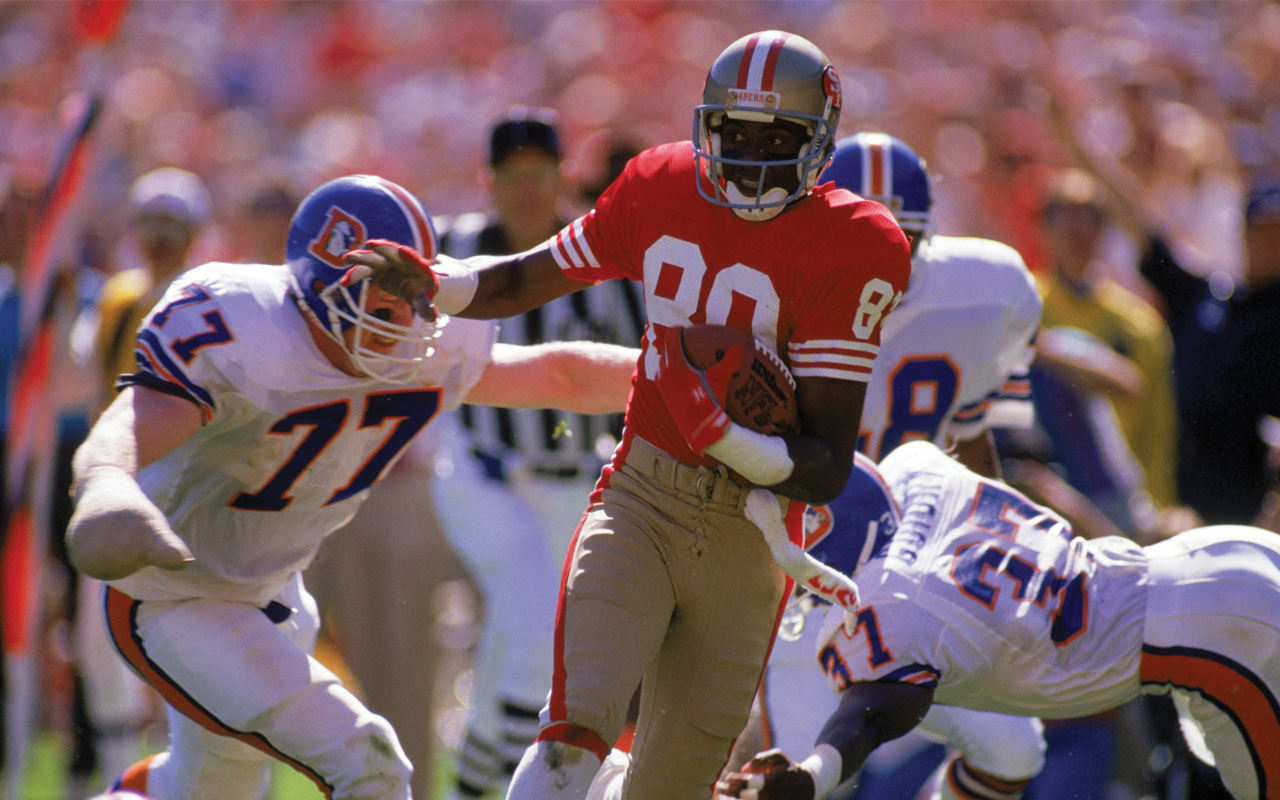
Jerry Rice won three Super Bowl titles with the San Francisco 49ers. Nicknamed “World” because of his superb catching ability, his accomplishments and numerous records, Rice is widely regarded as the greatest wide receiver in NFL history and one of the greatest players of all time.


